| Applications | |

Making of Bandra-Worli Sea Link
|
|
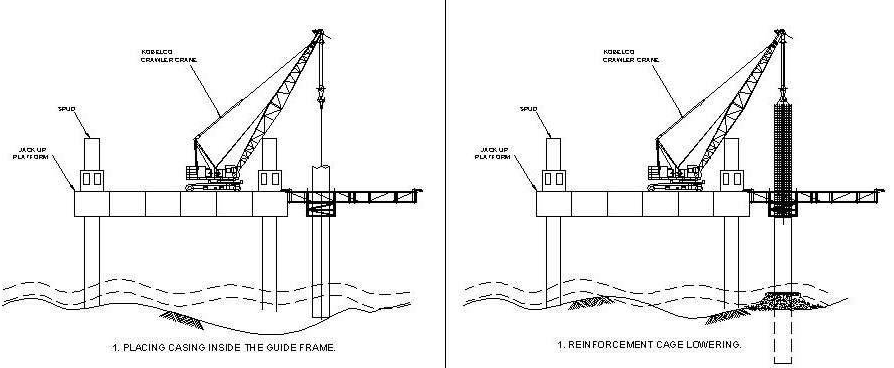 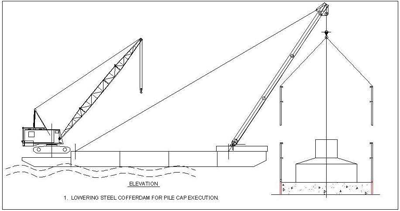 Superstructure The BWSL Project has (9+2) approach bridge modules. These modules range from 3 continuous span units to 8 continuous span units. The deck of the carriageways consists of triple cell precast box girders supported on piers founded on independent substructure. The Concrete Grade for the superstructure is M60. The average weight of the span is 1800 tons, whereas the heaviest span in the bridge (to be erected with the Launching Gantry) weighs 2000 tons. In addition, the trusses were to be designed to receive the segment from the already erected deck as well as from barges parked directly under the truss. Superstructure The BWSL Project has (9+2) approach bridge modules. These modules range from 3 continuous span units to 8 continuous span units. The deck of the carriageways consists of triple cell precast box girders supported on piers founded on independent substructure. The Concrete Grade for the superstructure is M60. The average weight of the span is 1800 tons, whereas the heaviest span in the bridge (to be erected with the Launching Gantry) weighs 2000 tons. In addition, the trusses were to be designed to receive the segment from the already erected deck as well as from barges parked directly under the truss.The Technical Data for the superstructure is as follows. Max Longitudinal Gradient = 1.72% Max Crossfall = 6% Max Radius in Plan = 600m Min Radius in Plan = 246m Typical Span Length = 50m and 30m in Link Bridge Max Span Weight = 2000 tons The erection gantry is 1260MT truss designed to erect spans for the above configuration. The unique feature of the truss indeed is the maximum span weight it can handle and that it can launch the pier and EJ segment itself. The truss also has the capacity to align the total span in hanging condition after the gluing is completed. The truss is fully mechanized for self launching and aligning. An individual segment can be aligned on the truss using a set of four hydraulic jacks mounted on each suspension frame. In order to eliminate the casting or erection errors within a span, two wet joints are provided on either end of the span. The wet joints are cast after finalization of the span alignment. For the fabrication of the truss, the entire structural steel (grade Fe 540) was sourced from within India. The accessories and components however were procured from India and abroad. A full scale load test was conducted before putting the erection gantry into actual operation. The erection gantry comprises the following: a. Main truss b. Front/rear pylons c. Front/centre/rear legs d. Front /rear trolley e. Cross beams f. Stressing gondola g. Suspension frames h. Connection beams-Type A/B i. Spreader beams- Type A/B j. Pier bracket k. Chain Support A Typical 50m span of the approach bridges comprises 15 field segments, a Pier segment and 200mm (nominal) in-situ wet joints. During the span construction, all field segments are suspended from the Gantry, glued and temporarily stressed together. Once the gluing operation is completed, span alignment to the Piers is followed. After alignment, the wet joints are cast including grouting of bearings top plinth. Once the wet joints achieve the required strength, stressing of longitudinal PT is commenced followed by load transfer of Span to Piers. 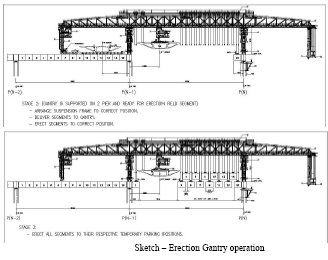 Relocation of Launching Trusses using 1600MT capacity Barge Mounted Crane – Asian Hercules After the successful erection of the deck on Bandra side, the trusses were required to be shifted across the Bandra cable stay bridge by 600 meters to Worli side to take up the spans Relocation of Launching Trusses using 1600MT capacity Barge Mounted Crane – Asian Hercules After the successful erection of the deck on Bandra side, the trusses were required to be shifted across the Bandra cable stay bridge by 600 meters to Worli side to take up the spansbeyond the Bandra Cable Stay. Various options like (i) dismantling of the trusses at present locations and reassembling them at new locations, (ii) lowering the trusses on a suitable floating craft and shifting and erecting them, and (iii) shifting the total truss using a floating crane, etc were analyzed in detail. Taking into consideration various constraints like limited working period available to execute the work in sea, the effect of open sea on dismantling and re-erection, etc, the best option available was the relocation of the trusses in one piece using a floating crane. Asian Hercules is one of the biggest floating shear leg cranes in the world. This crane is mounted on a barge which is over 240 feet long and more than 130 feet wide, weighs 5,900 tons and has enough lifting capacity (1600 MT) to lift a weight equal to 2,000 small cars. It started its voyage from Singapore on October 9, 2006, and arrived at Mumbai’s shores on October 27, 2006. After obtaining the necessary regulatory clearances, it commenced operations from November 06, 2006, including trial runs and realignments in its settings. Selection of equipment was done considering various challenges, like the draft and space available at working locations, tide limitations, and other weather constraints. The process: The biggest hurdle on the Asian Hercules operation was that the draft at the required locations was not good enough to carry out the operation smoothly without disturbing the VSNL cable lying underneath. This problem was overcome by using sophisticated global positioning system and carrying out the entire operation in a series of smaller operations during the favourable high-tide. First the Asian Hercules Crane was positioned at the required lifting position. A complex operation of balancing the vessel using ballasting was carried out as per the predetermined stages. Positioning of the vessel was done considering the draft requirements. A specially fabricated lifting spreader was fixed to the truss to facilitate the lifting. The truss load was taken by the crane in stages so that the lifting operation was smooth. Through computerized central monitoring, the load in individual lifting points was monitored to ensure that no point was overloaded. After taking the load, the Asian Hercules crane was moved to a safe location where enough water depth (draft) was available to park the crane with the truss. Then the crane with the truss was moved to a new location during the next high tide. The truss was then lowered on to the final location. The lowering of truss at the final location was achieved through Guides, which helped to achieve a final placement accuracy of ±50mm. The operation, which otherwise would have taken one complete year, was completed in matters of a few days. Cable Stay bridges It is for the first time that cable stay bridges have been attempted on open seas in India.  Coupled with the fact that the aesthetically designed pylons have an extremely complex geometry and one of the longest spans for concrete deck, the challenges encountered were indeed formidable. Coupled with the fact that the aesthetically designed pylons have an extremely complex geometry and one of the longest spans for concrete deck, the challenges encountered were indeed formidable.
Construction of Pylon Tower Legs |
“This project gave us an opportunity to showcase our equipment”
When did Elcome Technologies first get associated with HCC on the Bandra- Worli Sea Link Project? Leica equipment has been used on most of the Sea Link projects around the world and based on this experience we approached Hindustan Construction Company (HCC) sometime at the end of 2000 with our range of specialised equipments for the Bandra-Worli Sea Link (BWSL). The first Leica Total Station was supplied by us to HCC in early 2001. What were the equipment supplied for this project? To meet the demand for high accuracy coordinate measurements on the BWSL project we supplied high performance Leica Total Stations including the TCA 2003, the TCA 1800, the TCA 1201, the TCRM 1201 R 300 and the TC 1800. We also supplied the SR 510 GPS equipment. What kind of support did you provide HCC vis-à-vis the equipment that you supplied to them? We gave comprehensive application trainings at their site towards effective and optimal usage of the equipment. Moreover, these equipments in keeping the desired accuracies that are required for such a project, needed timely calibration checks and corrections – for this, besides providing them complete service support during the warranty, we also got into annual maintenance contracts for these equipment post their warranty period. We were thus able to provide timely service and calibration of the equipment at our service centre. Do you think being associated with the project gives Elcome Technologies any leverage for other similar projects? It has been a privilege to be associated with BWSL and the HCC team we worked with. Moreover the challenges in geometric control on the project were highly demanding and exacting. This gave us an opportunity to showcase our equipment and our expertise. Our experience with BWSL project will be a basis for us to promote our technology on other such projects too. |
Meeting challenges with innovation!
When did the work on the Bandra- Worli Sea Link project start? Hindustan Construction Company (HCC) was awarded Package IV of the Project and work started in September 2000, but was held up due to several reasons including environmental issues and protests by fishermen. In right earnest the work started in December 2004. On what basis was the distance between the piers and the height of the bridge decided? The span between the piers is 50m. This distance was arrived at after considering various factors, which included optimization between the foundation cost vs. the superstructure cost. If the piers are wide apart then the foundation cost comes down, but the superstructure becomes heavier and its cost goes up. Also the navigational requirements as in an emergency the smaller trawlers and boats should be able to pass between the piers. Moreover, more number of piers provide better wind resistance to the bridge. Why was the cable stayed bridge design chosen for the Bandra-Worli Sea Link? A cable stayed design has some inherent advantages compared to other conventional designs, the main being that it allows for larger spans. There were three main reasons why a large span was needed in case of the Bandra-Worli Sea Link: • A navigational channel for the fishermen and other sea faring vessels had to be maintained. Survey Challenges! Bandra Worli Sea Link Project
1. For those of us who use them, a bridge is a bridge; but for those who build them each bridge has its individuality. Please tell us about some of the bridges that you have worked on in the last few years. In the past 10 years, I have worked on 7 long span bridges. Each one posed unique technical challenges that were overcome by my teams. The Rion Antirrion Bridge, between the Peloponnese peninsula and the Greek mainland, is a four pylon, 2200 metre span across a seismic fault in the Strait of Corinth. The pylon bases are not fixed to the seabed, but rather rest on an engineered bed of gravel and inclusion pipe piles. Thus they are free to move during a seismic event, without sustaining damage. The deck is mounted to the pylons with telescopic ‘shock absorber’ energy dampers, so minor pylon movement can be accommodated safely. The Puente de las Americas cable stayed bridge spans the Panama Canal, about 15 km east of Panama City. The size of the ships that pass through the canal necessitated a very high navigation envelope beneath the deck, and the commercial ramifications of interrupting canal traffic meant that the entire bridge had to be constructed without the use of marine barges or floating cranes. The deck was cast in situ with movable shutters and one of the largest formwork travellers ever utilized in bridge construction. The other major technical challenge was that the deck erection started before the pylon construction was complete. This meant that if the deck was out of balance for some period of time, the pylon lifts had to be cast ‘out of plumb’ with the embedded cable anchors still set to tight angular tolerances. The Cooper River Bridge in Charleston, South Carolina was (at the time) the longest cable stayed bridge in North America. The slenderness of the pylon legs and the lack of a cross beam below the cable anchorages made pylon leg construction a challenge. The selection of PERI self climbing formwork made it impossible to place an instrument bracket on the formwork support frame, so we employed a Trimble DGPS solution. Early in the morning, immediately after a section of the pylon leg was cast, with the concrete in place for 4-6 hours, we installed a special instrument pedestal onto a ‘cast in’ pipe flange. The tower crane picked up a 15 ton test block (to make the mast load neutral) and then swung to a position that permitted the GPS receiver to receive the maximum number of ‘clean’ satellite signals. We used a set of three ‘one minute’ static position averages, capturing one position every second, to determine our XY position and an approximate Z. We corrected the weaker Z position by taping a ∆elevation up from the previous lift. We then replaced the GPS antenna with a Leica total station and obtained an angular orientation from a back sight, set about 2 km away. We set two auxiliary instrument brackets on the inside face of the exposed cable anchor box, and then surveyed their positions for use in a 3Dimensional ‘Best Fit’ solution. The actual as-built of the most recently cast lift took place 3-4 hours later, long after sunup and with the tower crane in full operation, but we could use a least squares solution to correct for temperature gradients and eccentric load induced tower deflections by turning off the internal compensators, observing the auxiliary bracket positions again, then taking measurements to our concrete lift as-built positions last. During post processing, we applied a 7 parameter similarity transformation to the observed data to perform the scale factor, rotations and transformations necessary to get the instrument position and the auxiliary bracket positions to match the 06:00 AM positions, before sunup and with the tower crane neutral. These transformation parameters were of course applied to the as-built measurements, to convert them to 06:00 AM readings. The Shaikh Zayed Bridge was not a cable stayed bridge, but rather a cast in place concrete deck supported by cable stays from a series of asymmetrical steel arches. This project was designed by Zaha Hadid, engineered by HPR and proved to be almost un-buildable, and absolutely unprofitable for the main contractor. It is currently 2 years behind schedule, with about 18 months to go until completion. I stayed on this project only until I found an exit strategy – the Sutong Bridge, in Nantong PRC. The Sutong Bridge is currently the world’s longest cable stayed bridge, with a clear span length of 1088 metres! By comparison, the Bandra Worli’s main span is 500 metres. Ultra long span bridges bring a myriad of technical challenges, which directly impact the project costs and construction schedule. Long decks require tall towers (to be able to accommodate the increased number of stay anchors, and still maintain the necessary angular cable geometry). Sutong’s pylons were 306 Metres in height, as compared to Bandra Worli’s tallest pylon at P19, at 124 Metres. The crossing of the Yangtze River, between Nantong and Suzhou has strong winds during most of the year so deck flutter and tower deflection were much more of a problem than thermal gradient induced deflections. The pylons were so tall, that after 200 metres, two auxiliary instrument positions had to be transferred onto the pylon, to perform set out and as-built surveys, similar to the Cooper River Bridge, however the Chinese chose a more traditional approach – a reciprocal observation procedure with a Leica 2003 total station. The rebar for the lifts above were much too tall to permit a GPS antenna to receive satellite data free from multi-path errors. The anchor boxes for the pylons were fabricated close to Beijing, and then barged down to Nantong. These boxes were quite similar to the Bandra Worli boxes, and the survey control methodology chosen was mine, a combination of metrology and steel fabrication ‘dimensional’ quality control. The only serious challenge in anchor fabrication is to achieve angular accuracy in the three planes (α, β and g), AFTER the welding is completed. Anticipating angular errors due to weld shrinkage, and mitigating unexpected results is almost an art – not a science. If the acceptance criteria for angular errors is +- 0.5 degrees (fabrication and installation errors combined) that means that the post weld fabrication error must be between +- 0.25 degrees and the pre-weld fit-up errors between +- 0.125 degrees. In an anchor plate of 400x400mm, that means making repeatable survey measurements of sub-millimetre accuracy. This level of accuracy demands the best 1st order instrumentation, on-board software, customized targeting and methodology available. Both the Nantong and the Bandra Worli anchor boxes were manufactured and installed within the designer’s tolerances. I also consulted to a bridge project in Canada, a long floating bridge in the province of British Columbia. The challenge they faced that prompted my involvement was completing the pylon leg construction once the pontoons were afloat. Again, I designed a system based on a 7 parameter similarity transformation, utilizing a total station that could operate with the internal compensators deactivated, and a series of control points originally established when the pontoon was still in the dry dock. 2.Could you please tell us briefly how a cable stayed bridge is different from other bridges? Cable stay supported bridges are a type of suspension bridge. A typical suspension bridge, like the Golden Gate Bridge in San Francisco, consists of two large diameter incrementally spun cables, hanging between the two main towers, on a catenary, with much smaller diameter vertical hangers spaced evenly along the deck, connected to the suspension cables. Cable stayed bridges have many smaller diameter cables, connecting the pylon legs to the deck at evenly spaced intervals. The pattern of pylon connection can vary. The parallel stay system is called a ‘harp’, the system that bunches the pylon anchors close to the top of the pylon is called a ‘fan’, but the most common style is to space the anchors from the pylon top downwards towards the deck. This system is called a modified fan. The longest spans still require a suspension bridge, but for the medium spans (100 – 1000 metres), cable stayed bridges may offer cost benefits and shorter construction schedules to the client. The suspension bridge needs large, expensive abutments to ‘anchor’ the suspension cables, and the time it takes to spin the suspension cables is lengthy. If the span distance permits, a cable stayed bridge alternative offers about 12 months gain in the schedule, as no spinning delays are required. A possible compromise is a hybrid design, where a portion of the bridge deck is partially suspended by cable stays, while the suspension cable is being spun, and then upon cable spinning completion, the mid span portion of the deck is suspended by hangers from the catenary cables. The cost benefit is slight with this alternative, so is rarely chosen. Multiple span cable stayed bridges are also a cheaper alternative for long span bridge designers, such as the Rion Antirrion Bridge in Greece. The minor drawback to this solution is that the navigational channel is cut into smaller portions by the extra pylons. 3.Please tell us about some of the survey related challenges you faced on the Bandra Worli Sea Link Bridge? The survey related challenges for the Bandra Worli were similar to most cable stayed bridges. The accuracy requirements are always demanding, especially in the fabrication of the cable anchor assemblies. The angular misalignment permitted is+- 0.5 degrees in the completed structure, so the fabrication and assembly tolerances are much tighter. We fabricated the bearing plate / guide pipe assemblies to +- 0.06 degrees from perpendicular. We placed them in the deck slab formwork (prior to concrete placement) within +- 0.125 degrees, to ensure that they would still be within +- 0.25 degrees after the concrete had been placed and the concrete curing shrinkage was complete. This procedure required custom design / manufacture of very accurate bearing plate/pipe sleeve assembly jigs, as well as special dual turnbuckle pipe sleeve support yokes and customized targeting and tooling for surveying the anchor assemblies in the deck sections. The fabrication of the pylon head anchor boxes was even more complex, as weld shrinkage had to be anticipated, and unforeseen results dealt with during erection. The size of the base plate that the bearing plate rests on is only 700×400 mm in dimension, so that means the fit-up survey measurements had to be accurate to sub-millimetre, to ensure the 0.125 degree angular misalignment specification was met. The pylon legs (below the tower head) were very slender, so were susceptible to thermal gradient deflections. Care had to be taken to ensure that all important surveys were performed in a thermally neutral state. The legs also deflected towards the pylon centre after concrete placement, so the ‘as-set’ positions were always different from the ‘as-built’ positions. The reference geometry supplied by the designer is based on Time ∞, whereas we were constructing every element at Time 0, so allowances had to be made for future creep, shrinkage and elastic shortening. These allowances are referred to as pre-cambers and over heights/lengths. For example, the over height for the P19 pylon’s tower head was +35 mm. As we completed the south carriageway first, the deck load was transferred into the pylon legs, causing the shared centre legs to shorten less than the single outer leg. This caused the pylon to temporarily incline away from bridge centreline by nearly 30 mm at the top of the tower head. This meant that we had to construct the north pylon’s tower head on a similar inclination, with the expectation that the pylon would come back to plumb when the load of the north deck was in place, bringing the pylon sub structure and common foundation back into equilibrium. 4.Could you please elaborate on the role of the pylons in a cable stayed bridge and the survey methodology that was used to put them up in the Bandra Worli Sea Link Bridge? The pylons of a cable stayed bridge are used primarily to anchor the upper cable stay sockets. Many times the deck is firmly attached to the pylons (as in the case of the Bandra and Worli spans) but other bridges only have sliding pot bearings at the pylons (Ting Kau Bridge, in Hong Kong), or elastomeric bearings between the tower’s cross beam and the underside of the deck (Alex Fraser Bridge, Cooper River Bridge). The pylon must be tall enough to provide sufficient space for all the cable anchors, and still yield a decent vertical angle at the uppermost cables. Obviously, as the alpha angle decreases with the height of the anchor above the deck, the amount of cable force in the vertical direction decreases as the force in the horizontal direction increases. This is why the diameter of the longest cables is greater than those nearest the pylon (with the steepest alpha angles). They have to be strong enough to resist the extra cable force applied, to yield sufficient upward lift to support the dead load and the live load (traffic) in the worst case scenario. The survey method utilized to construct the Bandra Worli pylons was based on the fact that the pylon legs were inclined. Inclined pylon legs pose a significant challenge to the contractor, as the rebar cage will have a natural tendency to sag down hill during construction. If a rebar cage sags, it will be out of tolerance when completed and clash with the formwork adjustment procedure during the final as-set survey. Our solution was to implement a sacrificial rebar template assembly, to guide the construction of the rebar cages and to ensure that there would be no clashes of the steel embedments, like crane tie-ins and DOKA climbing cones. Our surveyors set the rebar templates in the early morning hours, after the self climbing formwork was fixed for the next lift. These templates had 3 or 4 key points stamped onto them that the surveyors could shoot, and once the support framework was completely interconnected, formed a local survey network that moved with the pylon’s thermal deflections, yet was still based on a thermally neutral pylon. At any time, and with any amount of pylon leg deflections present, our surveyors could set up their instrument on the special brackets attached to the DOKA framework, disable the internal compensators and then perform a ‘resection’ or ‘free station’ operation to determine instrument co-ordinates and orientation, for set-out work. Once the concrete was placed, the pylon would deflect downwards towards the bridge centreline, so new co-ordinates of the rebar template were measured (again in the early hours of the morning). The instrument was again transferred up to the top of the pylon, installed on the same bracket, where the as-built survey could be completed quickly and accurately. The main challenge to these surveys was in the formwork construction. On most bridge pylons, there are 2 fixed panels and two adjustable panels, so fine adjustment at each corner is possible. For the Bandra Worli pylons, the formwork had no adjustability. Each panel butted up to the adjacent panels, so the entire shutter assembly acted as a solid body. To move the top into position, the entire shutter had to be tipped, similar to the survey alignment procedure of an elevator core shutter. If an error in a panel length cutting operation occurred, there was no way to eliminate this. Small errors could be mitigated by setting the shutters so that half the error was on one corner and the other have was on the opposite corner. Our survey alignment criteria was therefore based on the centroid of the entire shutter (6 point average in the pylon leg sections & 12 point average in the tower head sections), and not on individual corner positions. 5.In the Bandra Worli Sea Link project what were the phases in the construction where survey played a critical role. The phases of construction most dependent on survey were the following:
6. What kinds of survey instruments are best suited for the different survey works in a typical cable stayed bridge construction. The best instruments for cable stayed bridge surveying are state of the art, high accuracy, vibration tolerant electronic total stations, with ATR (automatic target recognition) and on-board software for Free Station and Resection. GPS receivers can also play a role, when the pylons are extremely tall (as in the Millau Bridge in France) or far out to sea. Their lack of accuracy in Z measurements is their only weakness, in my opinion. With improvements in multi-path error mitigation and the implementation of the Glonass satellites, the availability issue and PDOP are much improved. The exception to this high tech equipment is utilizing a pair of old fashioned tilting levels to perform accurate deck profiles. The vibrations present in cable stay supported decks makes internally compensated survey equipment susceptible to ‘compensator excitation’, producing a blurred image of the crosshairs in an auto level or randomly inaccurate vertical differences in total stations. A split bubble tilting level exhibits the deck vibrations in the movement of the tilting bubble – while the cross hair image remains completely stable. By adjusting the level so as to balance the bubble movement evenly, a level observation is possible. The purpose of having two instruments observing a single staff is that long circuits can be run ‘one way’. Each set-up produces two back sights and two foresights, so constitutes a closed level loop. The next set-up again produces 2 back sights and two foresights, which is again a closed loop. It is like building a chain, link by link. It was quite common to be able to level from P17 to P21, a distance of 600 Metres, with a misclosure of only 1-2 mm. 7.Could you tell us about the kind of accuracies that are needed for various aspects of a cable stayed bridge? There are many different accuracy requirements, in the steel fabrication/concrete casting and their related survey control measurements, as some types of errors can propagate or systematically multiply and others are essentially ‘one off’ – with no knock-on effects. Deck segment lengths are a typical dimensional component that has potential for systematic error propagation. A +1mm error on every 3M long deck segment of a 600 metre span will produce +100 mm errors at each expansion joint at the end spans, or roughly 10% of the thermal gradient expansion range. This is still an acceptable range of error, but 200 or 300 mm wouldn’t be, so deck lengths have to be measured accurate to the millimetre, and significant errors must be tracked during deck segment installation, and compensated for in the last in situ stitch joints cast. Installation of the first deck segment of a 16 segment block is another example of a potential systematic error situation. For every 1mm rotational error (in either the horizontal or vertical directions) there will be a 16mm error at the next wet joint. When setting these segments during wet joint construction, we measure the horizontal positions to the millimetre and the vertical differences to better than 0.5 mm. Cable anchorage placement errors in either the deck or pylon are minor, as there is usually a fairly generous range of cable length adjustment at the live end socket – either by split shims or by threaded sockets and lock nuts. A shift of 1 or 2 centimetres in longitudinal or transverse directions is insignificant, so normal survey procedures are quite capable of controlling installation and identifying absolute errors. The exception to this is angular misalignments. The principal of multi-strand stays, or parallel wire pre-formed stays is that each wire or strand carries an equal proportion of the cable force. If the bearing plate isn’t perpendicular to the cable force vector, then some wires will carry much more of their respective share of the force, and other wires will carry much less of the force. The over-stressed wires are therefore susceptible to premature fatigue failures. Most manufactures will provide a warranty period for their stays, providing the final angular alignments are within +-0.01 Radians (+- 0.57 degrees). Even with this ‘less than generous’ installation tolerance, longer guide pipes with a misalignment close to the limit will pose problems during damper installation. This is the one phase of works that requires the best survey equipment and methodology available, to produce repeatable measurements at sub millimetre accuracy. The actual positions of the anchors need to be measured accurately, only IF the cables are to be installed to length, instead of force. As absolute cable lengths at the installation forces are very difficult to determine, engineers rarely use length as an installation criteria, and instead choose force (as measured at the hydraulic jack pump). As long as the cable anchor socket has sufficient capacity for minor length errors, the cable length, deck anchor and pylon anchor locations need only to be within 2 cm of design. Pile driving and coffer dam positioning can be performed to +- 5mm without any detrimental effects, so is a perfect application for DGPS. 8.How important is the use of GPS for survey purposes in a cable stayed bridge project? How was it used in the Bandra Worli Sea Link Bridge project. The application of GPS in cable stayed bridge construction is quickly gaining acceptance, for specific tasks. While it can’t replace all traditional survey equipment – it does have cost benefits in certain applications. Bridges far from shore, very tall pylons, marine plant positioning, bathymetric vessel positioning, and construction site control networks are all perfect applications for DGPS. You can even use static GPS receivers for as-builts, provided the Z co-ordinates are not critical. In dynamic structures that require periodic monitoring, a DGPS system that logs reading once per second, over 24 hours is a much more cost effective solution than a two man crew with a total station and prism pole.
|
||||||||||||||||||||||||||||||||||


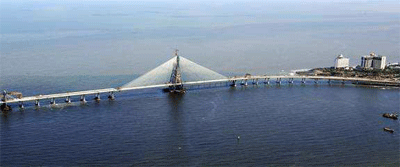
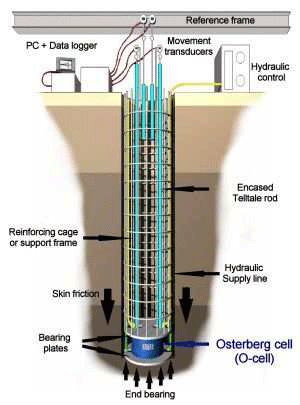 For conducting the load test on the piles, the load to be applied varied from 4500tons to 9600tons.
For conducting the load test on the piles, the load to be applied varied from 4500tons to 9600tons.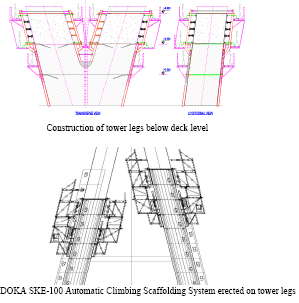 Construction of tower legs below deck level DOKA SKE-100 Automatic Climbing Scaffolding System erected on tower legs
Construction of tower legs below deck level DOKA SKE-100 Automatic Climbing Scaffolding System erected on tower legs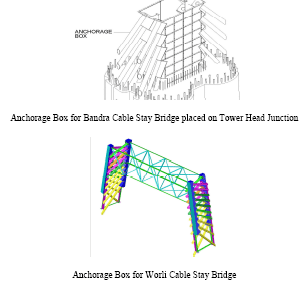 c. Compression struts
c. Compression struts
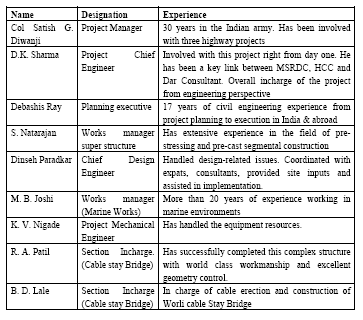
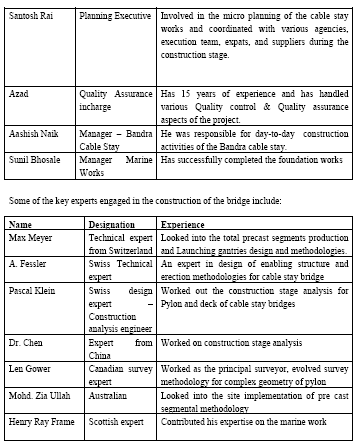













 (25 votes, average: 2.20 out of 5)
(25 votes, average: 2.20 out of 5)
Hi
I think this project is a part of the Western Freeway Sea Project, which, in turn, is a part of a larger proposal to upgrade the road transportation network of greater Mumbai.
GPS could play a great role in construction control.
Leave your response!
MY NEWS
ICAO Assembly condemns GNSS radio frequency interference ESA inaugurates new deep space antenna in Australia Galileo R&D tests new uplink antenna Japan to launch another positioning satellite NSG Geospatial Services launches “NeoMaps”
More...Order both the copies for FREE!
PREVIEW THE BOOK
PREVIEW THE BOOK
________________________________________
The Drone Rules in India 2021
________________________________________
National Geospatial Policy of India 2022
________________________________________
Indian Satellite Navigation Policy – 2021 (Draft)
________________________________________
Guidelines for acquiring and producing Geospatial Data and Geospatial Data Services including Maps
________________________________________
Draft Space Based Remote Sensing Policy of India – 2020
________________________________________
National Unmanned Aircraft System (UAS) Traffic Management Policy – Draft
________________________________________
Advertisement
Interview
Kiyokazu Minami
Secretary General, Executive Director, Japan Institute of Navigation
Member, Leader of GPS/GNSS research group, Japan Institute of Navigation
Easy Subscribe
Previous Issues
- Vol. XXI, Issue 9, September 2025
- Vol. XXI, Issue 8, August 2025
- Vol. XXI, Issue 7, July 2025
- Vol. XXI, Issue 6, June 2025
- Vol. XXI, Issue 5, May 2025
- Vol. XXI, Issue 4, April 2025
- Vol. XXI, Issue 3, March 2025
- Vol. XXI, Issue 2, February 2025
- Vol. XXI, Issue 1, January 2025
- Vol. XX, Issue 12, December 2024
- Vol. XX, Issue 11, November 2024
- Vol. XX, Issue 10, October 2024
- Vol. XX, Issue 9, September 2024
- Vol. XX, Issue 8, August 2024
- Vol. XX, Issue 7, July 2024
- Vol. XX, Issue 6, June 2024
View AllLog In
E-ZINE
- September 2025
- August 2025
- July 2025
- June 2025
- May 2025
- April 2025
- March 2025
- February 2025
- January 2025
- December 2024
- November 2024
- October 2024
- September 2024
- August 2024
- July 2024
- June 2024
- May 2024
View AllPartnership
17-18 September
Hyderabad, India
21 - 24 September 2025
Baška, Krk Island, Croatia
29–30 October 2025
Riyadh, Saudi Arabia.
3-5,November
Calgary, Canada
3-5 November 2025
Florianópolis, Santa Catarina, Brazil
24 – 27 November, 2025
Dubai, U.A.E..
23 - 25 February
London, UK
25-27 March 2026
Munich, Germany
31 March - 01 April 2026
Singapore
22-23, April 2026
Amsterdam, The Netherlands
7-8 April 2026
Washington DC, USA
28 – 30 April 2026
Vienna, Austria
21-23 May
Benidorm, Spain
11-13, May
Ottawa, Canada
12 - 13 October 2026
Jeddah, Saudi Arabia
View Past Events